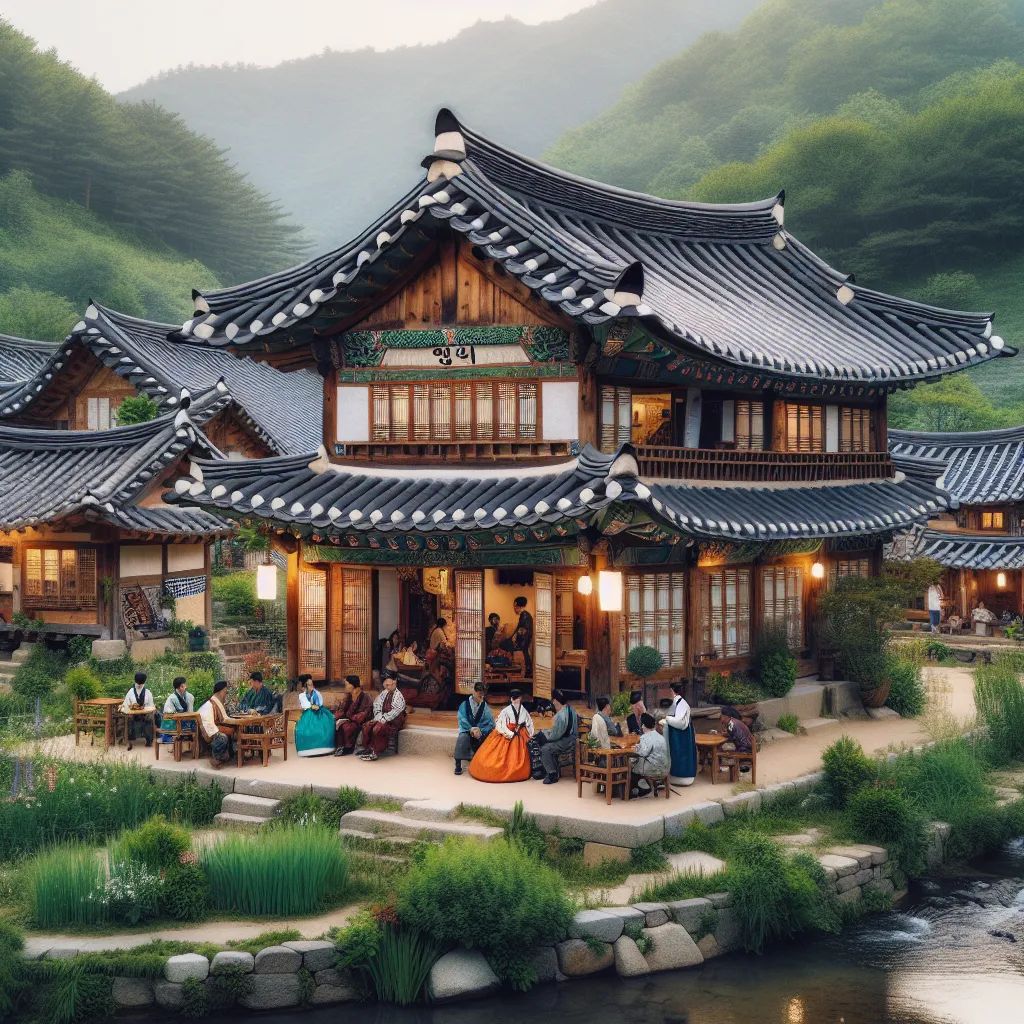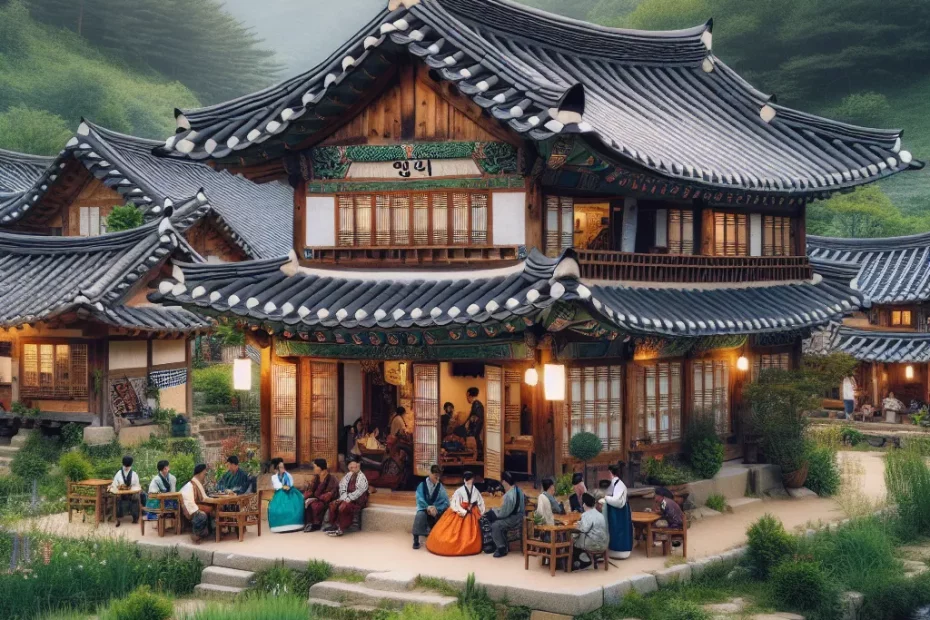Andong Hahoe Folk Village, nestled in the heart of South Korea, stands as a testament to the rich cultural heritage of the region. Its traditional architecture, cultural practices, and preservation efforts have garnered international recognition, with UNESCO designating it as a World Heritage Site. Exploring the village offers a glimpse into Korea’s past, showcasing a harmonious blend of history and tradition. The unique design elements and annual festivals held within the village provide a captivating insight into the daily lives and celebrations of its inhabitants. As we delve into the history and significance of Andong Hahoe Folk Village, we uncover a treasure trove of cultural wealth that continues to inspire and educate visitors from around the globe.

Exploring the History of Andong Hahoe Folk Village
Welcome to a journey through time as we delve into the rich history of Andong Hahoe Folk Village, a place steeped in cultural significance and heritage. Located in the heart of Korea, this traditional village offers a glimpse into the past, preserving the customs and way of life of generations past.
Historical Roots:
Dating back to the Joseon Dynasty, Andong Hahoe Folk Village has stood the test of time, maintaining its traditional architecture and layout. With over 600 years of history, the village has been designated as a UNESCO World Heritage site, showcasing the unique blend of Confucianism and shamanism in Korean culture.
Architectural Marvels:
Wander through the narrow lanes lined with thatched-roof houses, known as hanok, and marvel at the intricate wooden carvings that adorn the buildings. The iconic tile-roofed houses, called giwas, stand as a testament to the craftsmanship of the past, each telling a story of the families that once called them home.
Cultural Traditions:
As you explore the village, you’ll encounter various cultural performances and rituals that have been passed down through generations. From the mesmerizing mask dances to the soul-stirring Pansori performances, every corner of Andong Hahoe Folk Village resonates with the echoes of Korea’s cultural heritage.
Natural Beauty:
Nestled amidst the lush Nakdong River, the village offers a serene escape from the hustle and bustle of modern life. The surrounding landscape, with its rolling hills and ancient trees, provides a picturesque backdrop to the traditional village, inviting visitors to immerse themselves in nature’s tranquility.
Legacy of Generations:
The spirit of community and tradition runs deep in Andong Hahoe Folk Village, where residents continue to uphold age-old customs and practices. From the annual mask dance festival to the rituals performed to honor ancestors, the village serves as a living testament to the enduring legacy of Korean culture.
Join us on this immersive journey through Andong Hahoe Folk Village, where history comes alive and the echoes of the past resonate in every corner. Experience the cultural tapestry of Korea woven into the fabric of this ancient village, and discover the timeless beauty that continues to captivate visitors from around the world.
Traditional Architecture and Design Elements
The traditional architecture and design elements found in Andong Hahoe Folk Village are a true reflection of Korea’s rich cultural heritage. The village, with its well-preserved hanok houses and intricate design details, offers a glimpse into the past and showcases the craftsmanship of the Korean people.
Unique Architectural Style
The hanok houses in Hahoe Folk Village are characterized by their unique architectural style, featuring curved tiled roofs, wooden beams, and heated stone floors known as ‘ondol.’ These traditional houses are designed to harmonize with the natural surroundings, often incorporating elements such as a central courtyard or garden to create a peaceful and serene atmosphere.
Use of Traditional Materials
One of the key design elements in Hahoe Folk Village is the use of traditional materials such as clay, wood, and thatch. These materials not only provide insulation and durability but also contribute to the overall aesthetic of the village. The intricate wooden lattice work, known as ‘chamke,’ is another distinctive feature of the architecture, adding a sense of elegance and sophistication to the buildings.
Layout and Principles
In addition to the architectural features, the layout of Hahoe Folk Village is carefully planned to reflect the principles of feng shui and Confucianism. The village is situated in a picturesque location, surrounded by mountains and a river, with the houses arranged in a way that promotes harmony and balance. This thoughtful design not only enhances the beauty of the village but also creates a sense of unity and community among its residents.
Practical Purposes
Furthermore, the traditional architecture of Hahoe Folk Village is not just visually appealing but also serves practical purposes. The hanok houses are designed to withstand Korea’s harsh climate, with the curved roofs helping to channel rainwater away from the structure and the heated ‘ondol’ floors providing warmth during the cold winter months.
Overall, the traditional architecture and design elements of Andong Hahoe Folk Village play a crucial role in preserving Korea’s cultural heritage and showcasing the ingenuity and craftsmanship of the Korean people. By exploring these architectural treasures, visitors can gain a deeper appreciation for Korea’s rich history and traditions. 🏯🌿✨
Cultural Practices and Festivals
Steeped in tradition and rich heritage, Andong Hahoe Folk Village in South Korea stands as a testament to the cultural practices and festivals that have been preserved for centuries. This UNESCO World Heritage site is a living museum, offering visitors a glimpse into the past through its vibrant celebrations and age-old customs.
The Hahoe Mask Dance Drama
The village is renowned for its Hahoe Mask Dance Drama, a traditional performance that combines music, dance, and storytelling. This ritual, dating back to the Joseon Dynasty, features performers wearing colorful masks representing various characters, from noblemen to peasants, and is accompanied by rhythmic drumbeats that echo through the village. The Mask Dance Drama not only entertains audiences but also serves as a means of passing down historical narratives and moral lessons from generation to generation.
Annual Festivals
Throughout the year, Andong Hahoe Folk Village hosts a variety of festivals that showcase its cultural heritage. One such event is the Hahoe Byeolsin Gut, a shamanistic ritual held to honor the village’s guardian spirits and ancestors. During this ceremony, shamans perform sacred dances and rituals to ensure the well-being of the community and to seek blessings for the future. The festival is a colorful and lively affair, with participants adorned in traditional attire and the air filled with the sounds of chanting and drumming.
Another highlight of the village’s calendar is the Andong Mask Dance Festival, a modern celebration that pays homage to the traditional art of mask dance. This annual event brings together performers from across the country to showcase their skills and creativity, with elaborate masks and costumes adding a touch of theatrical flair to the proceedings. Visitors can immerse themselves in the world of Korean folklore and mythology, experiencing firsthand the magic and mystery of the mask dance tradition.
Community Events
In addition to these major festivals, Andong Hahoe Folk Village also hosts smaller events throughout the year, such as traditional craft workshops, music performances, and culinary demonstrations. These activities offer visitors a hands-on experience of Korean culture, allowing them to participate in age-old practices and learn about the customs that have shaped the village’s identity.
As a hub of cultural preservation and community spirit, Andong Hahoe Folk Village continues to uphold its traditions and celebrate its heritage through a diverse range of practices and festivals. By immersing oneself in the vibrant tapestry of events and activities, one can truly appreciate the depth and significance of Korea’s cultural legacy. Visit Andong Hahoe Folk Village to witness firsthand the magic of its cultural practices and festivals, and embark on a journey through time to discover the heart and soul of Korea’s heritage! 🎭🎉🏮
Preservation Efforts and UNESCO Recognition
In the realm of cultural heritage preservation, Andong Hahoe Folk Village stands as a shining example of dedicated efforts to safeguard Korea’s rich legacy. With a history dating back over 600 years, this traditional village has been meticulously preserved to offer a glimpse into the past and showcase the unique cultural heritage of Korea. The meticulous preservation efforts have not gone unnoticed, as Andong Hahoe Folk Village was inscribed on the UNESCO World Heritage List in 2010, solidifying its global significance.
Commitment to Cultural Heritage Preservation
The preservation of Andong Hahoe Folk Village is a testament to the unwavering commitment to conserving Korea’s cultural heritage for future generations. Through meticulous restoration work and ongoing maintenance, the village has retained its authentic charm and historical integrity. The traditional thatched-roof houses, known as hanok, and the layout of the village reflect the architectural style of the Joseon Dynasty, offering a window into Korea’s past.
UNESCO Recognition and Cultural Significance
UNESCO’s recognition of Andong Hahoe Folk Village as a World Heritage site underscores its universal value and cultural significance. This prestigious designation not only acknowledges the village’s historical importance but also highlights the efforts made to preserve and promote its cultural heritage. Visitors from around the world flock to Andong Hahoe Folk Village to experience its timeless beauty and immerse themselves in Korea’s rich cultural traditions.
Global Model for Cultural Heritage Conservation
The meticulous preservation efforts at Andong Hahoe Folk Village serve as a model for cultural heritage conservation worldwide. By maintaining the authenticity of the village and showcasing its cultural significance, Korea has set a high standard for preserving its heritage. The recognition by UNESCO further elevates Andong Hahoe Folk Village to a global stage, where its cultural value can be appreciated by people from all walks of life.
In conclusion, Andong Hahoe Folk Village’s preservation efforts and UNESCO recognition highlight the importance of safeguarding cultural heritage for future generations. Through dedicated conservation work and global recognition, this traditional village continues to stand as a beacon of Korea’s rich cultural legacy, inviting visitors to step back in time and experience the beauty of its past.
Andong Hahoe Folk Village stands as a testament to Korea’s rich cultural heritage, offering a glimpse into the country’s traditional way of life. With its well-preserved architecture, unique design elements, and vibrant cultural practices, the village provides a valuable insight into the past. The annual festivals and events held at Hahoe Folk Village further showcase the enduring traditions and customs of the Korean people. Through dedicated preservation efforts and recognition by UNESCO, this historic site continues to be a source of pride for the nation. Andong Hahoe Folk Village truly embodies the essence of Korea’s cultural identity and serves as a living museum of the country’s heritage.
